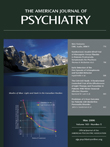To The Editor:
We read with interest the letter submitted by Drs. Doi and Usui regarding our article. Several points are made in their letter. First of all, the authors state that our main finding, that subjects inheriting the high-risk haplotype in
DTNBP1 had higher levels of negative symptoms than expected by chance, “was derived from the observation that the high-risk haplotype frequency was higher in the subjects in the upper 40th percentile for the negative symptom factor.” Actually, our results were not derived from analyses of the frequency of the high-risk haplotype in the various clinical subgroups, although frequencies were provided in our table. Rather, we employed the Transmission-Disequilibrium Test
(1) . This is a popular family-based association method that tests for excess transmission of alleles (or haplotypes) from heterozygotic parents to affected offspring. This transmission information, moreover, is not present in allele frequencies, which are derived from examining the entire group as a whole. In our experience, employing case-control methods, which are based on allele frequencies, in our group of 270 high-density schizophrenia families is less powerful than family-based tests such as the Transmission-Disequilibrium Test.
Second, they state that the “frequency of the high-risk haplotype was higher in the upper 20%–40% subgroup for the negative symptom factor than in the upper 0%–20% subgroup.” Actually, the two groups that we tested were 1) the upper 0%–20% subgroup and 2) the 0%–40% subgroup. Therefore, the former was a subset of the latter group, comprising approximately half of it. Although we saw no preferential transmission to the 0%–20% group, we interpreted this as being due to insufficient power to detect association, which was recovered when we broadened our definition of affection to additionally include subjects in the upper 21%–40%. We believe that the interpretation of Drs. Doi and Usui, i.e., that these results suggest a protective effect of the DTNBP1 high-risk haplotype, would therefore not follow. As an additional check, we went back to analyze the 21%–40% group. We found that the ratio of observed-to-expected transmissions was basically the same as that in the 0%–20% group.
Our interpretation of the results is that the
DTNBP1 high-risk haplotype preferentially increases risk for a more or less specific clinical form of illness, namely, one that is associated with higher levels of negative symptoms. It is not clear to us that this has implications for a protective effect of the
DTNBP1 genotype on the illness. A protective effect requires that one or more haplotypes be less likely to be transmitted to affected offspring than would be expected by chance. In the case of
DTNBP1, if the high-risk haplotype were truly protective against negative symptoms, then it should be transmitted to all groups defined by high levels of negative symptoms (i.e., 0%–20%, 0%–40%, and 21%–40%)
less— not more—as we observed, than would be expected by chance. In furthering their argument, Drs. Doi and Usui adduce results indicating that the neuregulin 1 high-risk haplotype was associated with nondeficit (not deficit) schizophrenia (Bakker et al. in previous letter). We believe that these data can just as well be interpreted in a similar way as our data and that these haplotypes increase the risk of a more or less specific form of illness. We have previously called genes containing such haplotypes “modifier-susceptibility genes”
(2) . Finally, we would like to thank Drs. Doi and Usui for their interest in our article and hope that we have provided some clarity on the topic.

